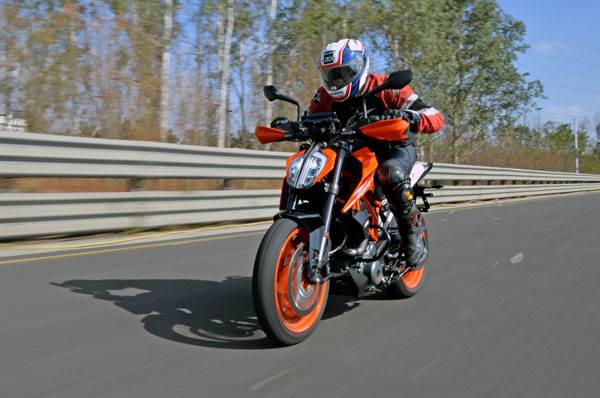2017 KTM Duke 390 review, test ride
The new 390 Duke looks meaner than before and is more manageable with major upgrades in features and equipment.
Published on Mar 10, 2017 06:40:00 PM
93,402 Views
Follow us on



How does it ride?
The 2017 390 Duke is powered by the same 373cc, liquid-cooled, single-cylinder unit as its predecessor, with the power figure unchanged at 43.5hp at 9,000rpm and peak torque bumped up by 2Nm to 37Nm at 7,000rpm. The torque bump has been facilitated by the use of a larger airbox. Other powertrain changes include the addition of ride-by-wire throttle.
On track, you immediately notice the effect of the ride-by-wire throttle – the opening, closing and modulation of your throttle is wonderfully smoothened out, giving you much more control over the manner and quantum of power delivery. And speaking of power delivery, you have access to a whole lot of power at almost any point in the rev range, though it is most concentrated in the middle, between 4,500 and 8,500rpm. Stay in that powerband and you will either have a grin or the God-have-mercy look plastered on your face. Getting to the powerband is not much of a task either, the short gearing ensures that twisting the throttle sends the (digital) tacho needle spinning madly towards the red. The limiter will cut you off at 10,500rpm, but until then, there is no abating in power delivery or that loud, raucous exhaust note. The 390 does not feel very comfortable in lower revs, which might be an issue in traffic, but a final verdict on that will have to wait till we conduct our road test.

Another feature which really makes the riding experience brilliant is the slipper clutch. While not a new feature, it is still very welcome; hard downshifts are surprisingly smooth, with barely any rear wheel lock or squirm.
It comes as no surprise that this bike is absolute dynamite around corners. Attacking a corner feels almost intuitive – the chassis, suspension and tyres all work together in wonderful sync to take you round gracefully, safely and most importantly, quickly. The wheelbase has been shortened by 10mm, which makes the bike that much easier to flick in and out of a bend, and once again, the ride-by-wire throttle comes in handy, allowing you to throttle more progressively than before as you make your way around the turn.
Brilliant cornering ability does not imply lacklustre stability on straights. We torpedoed down the back straight of the Chakan track, beyond a speedo-indicated 150kph mark, and the 390 stayed impressively stable.

The suspension setup has been upgraded too – while the front suspension still consists of WP-manufactured 43mm upside-down forks, they now come with open-cartridge technology; the rear suspension, meanwhile, continues to consist of a WP-manufactured monoshock that is pre-load adjustable. At low speeds, the ride, as tested on a patch of rumblers and paver blocks, is a bit jarring, though things smoothen out considerably as you pick up pace. Bigger ditches are best handled at a crawling pace.
Also improved is the stopping power. The 390 Duke now comes with a Bybre 320mm front disc (as compared to its predecessor’s 300mm disc) chomped on by radially-bolted four-piston calliper and a 230mm rear disc bitten by a single-piston floating calliper, armed with switchable two-channel Bosch-developed ABS. The braking is forward-biased and is mighty effective, as necessitated by the engine’s massive firepower. The ABS too has received an upgrade, it gets three modes now – Off, Road and Supermoto. The Off mode, obviously, implies that the ABS is turned off, while Road implies that ABS is functional in the front and back. The Supermoto mode keeps only the front ABS on while switching the rear off, for those who want to have some fun.
The 390 Duke rides on Metzeler M5i’s as before. However, the speed rating on these tyres has gone down from ‘W’ to ‘H’, which means they are good for speeds up to 210kph. Nevertheless, the tyres provide good levels of grip.
And finally, we come to the seating position. The seat is slightly higher than before and the foot pegs are pushed back a bit, making for a more comfortable seating position. It is still very upright, perfect for urban riding and lesser cramped than before.
Copyright (c) Autocar India. All rights reserved.

















Comments
Member Login
Personal Details
No comments yet. Be the first to comment.